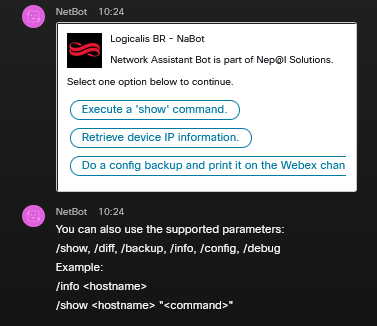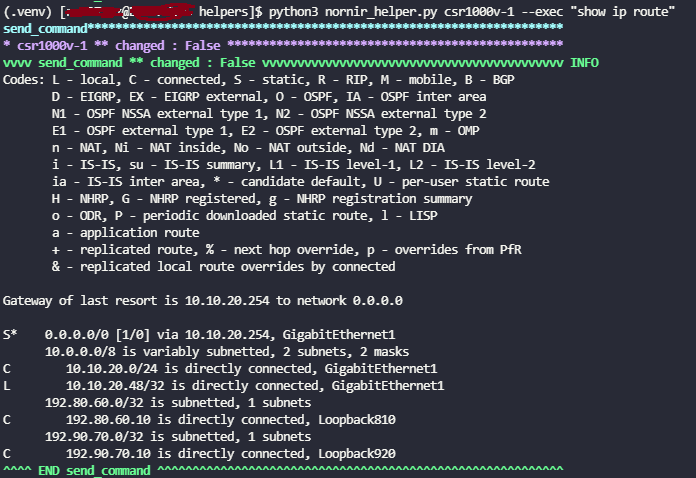A sample Cisco Webex bot with Netbox integration and Nornir+Scrapli for Automation. Run show commands, configure devices and get backups from Webex Teams.
This is meant to be used as an example on how to build a Cisco Webex Bot with netbox Integration (via the nornir_scrapli inventory plugin). This bot is based on docker-webexteams-bot-example and adds pyadaptivecards functionalities for handling user input. The bot is based on flask and will be configured to receive webhooks via http requests using ngrok.
The bot allows users to input actions to be executed (currently allows to run EXEC mode commands and generate configuration backups for single Cisco devices) and receive the outputs directly on their Webex conversation.
Platforms where the automation backend was tested:
- Cisco IOS XR
- Cisco IOS XE
Since the backend relies on nornir and scrapli, this should also work on Cisco IOS devices and Juniper JUNOS devices.
- Prerequisites
- Create Bot Account on Webex
- Setup Network Assistant Bot
- Setup Netbox Inventory
- Test nornir backend locally
- Start a Conversation with the Bot
- FAQ
Most of the software will be installed inside a container running on docker.
- Docker-compose
- Git
You will need to create the bot and generate and API token from developer.webex.com. Be sure to save the API token once it's created as you'll need it when setting up the bot!
Git clone this repository to a local directory:
cd /path/to/local/repository/
git clone --recurse-submodules https://github.com/LogicalisBR/NaBot.git
The file config/nornir_config_example.yaml is a nornir configuration file. Rename it to config/nornir_config.yaml and change Netbox URL to point to your Netbox IP address and port number. You can also use the docker-compose file to start a netbox container locally with default credentials (see below).
Also, update the config/config_example.yaml with the Token you previously generated for your bot and rename it config/config.yaml. This is how the Bot will authenticate with the Webex API.
If you already have a Netbox instance in your network, you may just build the main container.
# Building for the first time
./build.sh
# If needing to rebuild after making changes
./rebuild.sh
# Start the container once it's built
./run_nabot.sh
Alternatively to running the above scripts, you can use docker-compose to instantiate nabot + a local netbox container with default credentials.
docker-compose build
docker-compose up -d
The docker-compose instantiates two containers:
- nabot automatically mounts the network_assistant_bot/, helpers/ and config/ directories, so you can customize the code and configuration on these directories.
- netbox will be available locally on port 8000 (open a web browser and visit localhost:8000).
Default credentials for the Netbox container are:
- username: admin
- password: admin
- api key:0123456789abcdef0123456789abcdef01234567
You must supply the API key to the nornir_config_example.yaml file for it to be used as an inventory. The nornir config file is also read by the Netbox helper script to automatically onboard devices on Netbox using its URL and token.
---
inventory:
plugin: NetBoxInventory2
options:
nb_url: <NETBOX_URL> # URL in the format http://<ip-address>:<port-number>
nb_token: <NETBOX_API_TOKEN> # API Token for Netbox
ssl_verify: False
transform_function: "convert_host_data"
runner:
plugin: threaded
options:
num_workers: 10
ssh:
config_file: '../ssh_config'A Netbox helper script was written to facilitate device onboarding with some sample devices from the always-on Cisco's Devnet Sandbox. The script can be found under helpers/netbox_helper.py. The devices to be onboarded are listed in a yaml file (config/devices.yaml) and by default contains two DevNet routers (iosxr1 and csr1000-v from the IOSXR and IOSXE always-on labs). More devices can be onboarded by adding more elements to the YAML file.
devices:
- name: <hostname> # Must be identical to the hostname on the device
site: <site> # Free form string for Netbox site
tenant: <tenant> # Free form string for Netbox tenant
platform:
name: <platform> # must be either cisco_ios, cisco_iosxr or cisco_iosxe, used by Scrapli
manufacturer: <manufacturer> # Free form string for manufacturer name
type:
name: <name> # Free form string for Netbox device type
model: <model> # Free form model for Netbox device model
role: <role> # Free form string for Device Role
status: Active
interfaces:
Loopback0:
ipv4_address: <ipv-address> # IP of the device with mask, X.X.X.X/X
primary: Yes # One primary IP Address MUST be specified, used by scrapliThe onboarding script reads from the config/devices.yaml file and automatically onboards the devices, including their interfaces and IP Addresses, if multiple exists.
To execute the onboarding, enter the Nabot container and run it:
docker exec -it <container-id> /bin/bash
cd /workspace/helpers/
python3 netbox_helper.pyOnce you have at least one host on your inventory, you can use the network_assistant_bot/nornir_helper.py file from the CLI in order to test if the nornir-scrapli backend is running correctly. The input is of the format:
The back-end can be tested from inside the running container:
docker exec -it <container-id> /bin/bashUsage instructions
python3 nornir_helper.py [hostname] [--inventory] [--exec COMMAND] [--backup] [--config "multiline config"] [--dry-run "multiline config"]
For example, this command would print out the Nornir dictionary for host iosxr1, with all data it gathered from Netbox in dictionary format, excluding password.
python3 nornir_helper.py iosxr1 --inventory
This syntax can be used to run arbitrary exec mode commands.
python3 nornir_helper.py iosxr1 --exec "show ip int brief"
Sample test result:
Configuration blocks can also be sent via the CLI. They will use nornir_scrapli diff_cfg and commit_cfg methods. The return string will be a scrapli side-by-side-diff
python3 nornir_helper.py iosxr1 --dry-run "ntp server 1.1.1.1"
Once the bot is running on its container, you can open a new conversation with the bot using the e-mail address you configured previously (@webex.bot). In order to talk to it, mention it in a message with @. This will bring up the adaptive card requiring one ACTION to be used, these are:
- INFO will print the IP address for the given device name on Netbox
- DEBUG will print the IP address for the given device name on Netbox
- EXEC will execute a EXEC command on the device (same as --exec on the CLI), also requires the command to be specified as input
- BACKUP will generate a config backup in text format and print it on the Webex channel (in the future, backups will be handled as file attachments)
Separate NetBox tenants are used to derive the authentication credentials on devices. Consult the function convert_host_data for details and examples. Native Netbox does not have support for secrets, so instead we populate the username and password fields on the host dictionary with hardcoded values (username = admin, password = C1sco12345 for most devnet always-on sandboxes) if they are on the Sandbox tenant.
If the device does not belong to the Sandbox tenant, a function set_secret_credentials is imported from the helpers/credential_helper.py and used as a transform to provide authentication credentials. You must supply this file yourself or customize the code under convert_host_data in order to assign host.username and host.password to each device.
The following base docker images were used to faciliate development of this Webex Bot:
$ ./run_nabot.sh
Error response from daemon: No such container: nabot
Error: No such container: nabot
- Just wait a couple of seconds before trying again


